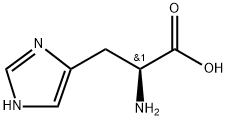Uses
Poly-L-histidine has been used:
- as a polycation for the dispersion of multi-wall carbon nanotubes (MWCNTs)
- as a polyionic compound to investigate its ability to rupture extracellular enveloped virus membrane
- in screening its anti-prion activity in cell based and in vivo anti-prion assay
Definition
ChEBI: Histidine is an alpha-amino acid that is propanoic acid bearing an amino substituent at position 2 and a 1H-imidazol-4-yl group at position 3. It has a role as a metabolite. It is an alpha-amino acid, a member of imidazoles, an aromatic amino acid and a polar amino acid. It contains a 1H-imidazol-4-ylmethyl group. It is a conjugate base of a histidinium(1+). It is a conjugate acid of a histidinate(1-).
General Description
Poly-L-histidine is an amphoteric compound. The imidazole ring in its structure enables protonation?deprotonation.
Biochem/physiol Actions
Poly-L-histidine (Phis) copolymers are biocompatible, pH responsive and are less toxic. It exhibits endolysosomal escape funcationality. The copolymer of Phis with poly(ethylene glycol)?poly(d,l-lactide) (PEG-PLA) is effective in delivering doxorubicin. pH sensitive poly(l-histidine) copolymer micelles have application in delivering anticancer drugs in acidic microenvironment.
